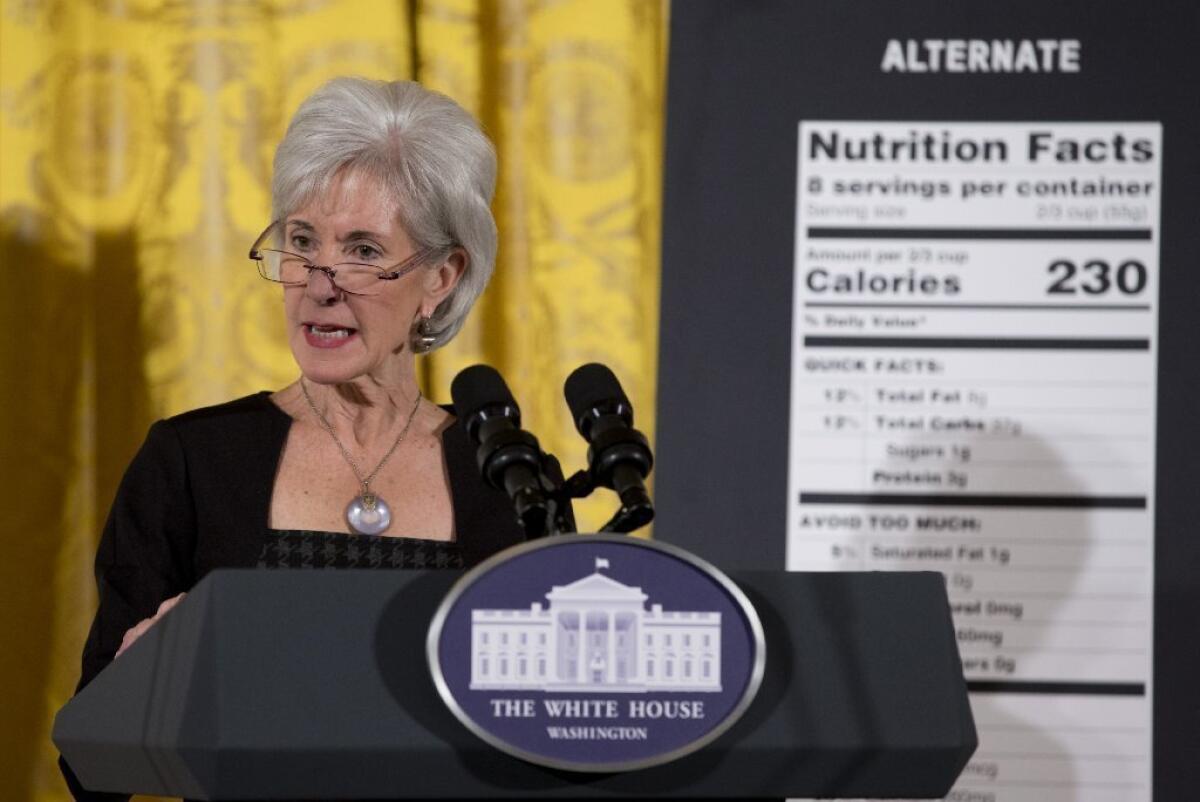Food nutrition labels get a makeover

- Share via
Aiming to give Americans the tools to make healthier dietary choices, the Food and Drug Administration has unveiled a revamped version of one of the nation’s most recognized graphics -- the “Nutrition Facts” box that appears on the back or side of packaged foods and beverages.
The proposed new information box increases the visibility of the “serving size,” allowing consumers to see without mental gymnastics the size of a normal portion, as well as the nutrients it contains.
It advertises the calorie content of a serving in larger typeface than any other information on the label, shouting a clear message over the cacophany of dietary advice: that too many of these are, first and foremost, the cause of obesity.
The proposed new label adds information that allows consumers to distinguish “sugars” found naturally in a product from those that have been added, boosting calories while also, perhaps, enhancing taste and driving a consumer’s impulse to eat more of it.
The dreaded reference to “calories from fat” -- which once held pride of place at the top of the label -- has been stricken from the revamped box altogether. That move reflects mounting evidence that all fats are not equal: while some types contribute to heart attacks and strokes, others are a crucial part of a healthy diet. A serving’s total fat content, and grams of saturated and trans fats -- notorious culprits in cardiovascular disease -- are prominently displayed at the head of the nutrient list. (Unsaturated and polyunsaturated fats -- generally plant-based fatty acids that, despite their high calorie content, have been found protective against some diseases -- are not tallied per se, but make up the unspoken remainder when saturated and trans fats are subtracted from total fat.)
The proposed new format for nutritional labeling is to be the subject of public comment for the next 90 days, after which it is expected to appear on all product packaging seen in grocery stores, convenience marts, vending machines and pushcarts.
The reimagined information labels are a clear reflection of the nation’s public health agenda, and how it has changed since the labels first appeared on packaged food in 1993. A product’s serving size and the calories it delivers -- both of which have grown to fuel an epidemic of obesity in the United States -- have been moved front and center. While earlier versions of the nutritional box focused on vitamins and minerals delivered, calories and serving size would become unmistakably clear to consumers, said Michael R. Taylor, the FDA’s deputy commissioner for foods and veterinary medicine.
The FDA underscored that its choices for “serving size” were not a finger-wagging effort to induce Americans to curb their growing portions. “By law,” FDA Commissioner Margaret A. Hamburg wrote Thursday in her FDA blog, “serving sizes must be based on what people actually eat, not on what people ‘should’ be eating.”
The new box also sets into higher relief information about what percentage of a healthy daily diet a product’s single serving provides. Here, too, the FDA is determined to cut through the noisy debate over what nutrients should best be reduced or amplified to maximize health. Weight- and health-conscious Americans may focus on a wide range of measures -- calories, carbohydrates, sodium or “good fats” -- to reach their goals, but in drafting the new labels, federal public health officials have been dogged in setting a single standard of recommended “daily values,” and displaying it in ways that consumers will see and act on.
The new labels also reflect new research -- and new vogues -- in vitamins and minerals good for the nation’s health. While vitamins and minerals once trumpeted on the nutritional labels (niacin! Vitamin B12!) have gone by the boards, a few remain, and a few have been added.
Lovers of Vitamins A and C will find an accounting of those nutrients missing on the proposed new label, replaced by Vitamin D and the mineral potassium. Those additions come against the backdrop of research linking Vitamin D deficiencies to a wide range of health ills, including depression, obesity and diminished immune response, and potassium deficits to heart rhythm disorders, hypertension and muscle weakness.




